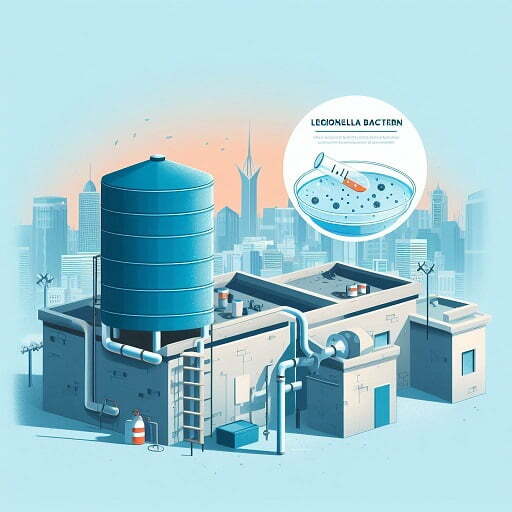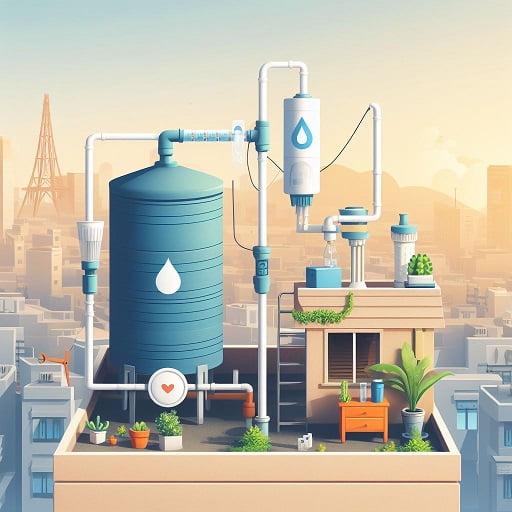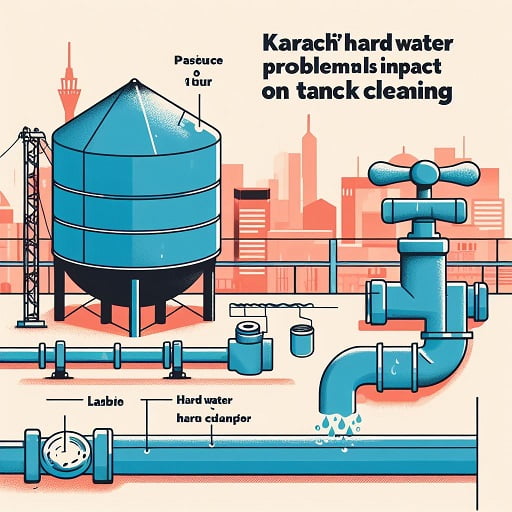Water is essential for life, but it can also be a source of disease and death. One of the most dangerous waterborne pathogens is Legionella, a type of bacteria that can cause severe respiratory infections in humans. Legionella can grow and spread in water systems, especially in warm and stagnant water tanks. In Karachi, Pakistan’s largest city, millions of people rely on water tanks for their daily needs, but many of these tanks are contaminated with Legionella and pose a serious health risk to the population. This article aims to raise awareness about Legionella bacteria, its impact on Karachi’s water tanks, and the ways to prevent and control its growth.
Legionella Bacteria: What You Need to Know
Understanding Legionella Bacteria
Legionella bacteria are found naturally in freshwater environments, such as lakes, rivers, and streams. They are usually harmless in low numbers, but they can multiply rapidly under certain conditions and cause infections in humans. The most common infection caused by Legionella is Legionnaires’ disease, a severe form of pneumonia that can be fatal if not treated promptly. Another infection is Pontiac fever, a milder flu-like illness that usually resolves without treatment.
Legionella Bacteria in Water Systems
Legionella bacteria can enter water systems through various sources, such as soil, rainwater, groundwater, or sewage. They can survive in water pipes, faucets, showers, cooling towers, air conditioners, humidifiers, fountains, spas, and hot tubs. However, they are most likely to grow and spread in water tanks that store warm water for domestic or industrial use. Water tanks provide ideal conditions for Legionella growth, such as high temperatures (between 20°C and 50°C), low chlorine levels, stagnation, sediment buildup, corrosion, and biofilm formation.
Legionella Bacteria in Karachi’s Water Tanks
Water Supply and Distribution in Karachi
Karachi is the largest and most populous city in Pakistan, with an estimated population of over 20 million people. The city faces a chronic water crisis due to insufficient supply, high demand, poor infrastructure, mismanagement, corruption, and theft. According to a report by the World Bank, Karachi receives only 55% of its water requirement from the Indus River and Hub Dam. The rest of the water is supplied by private tankers that fetch water from illegal boreholes or contaminated sources.
Water tanks are widely used in Karachi to store water for household or commercial purposes. They are usually made of concrete or plastic and vary in size and shape. They are installed on rooftops or underground and connected to water pipes or pumps. Water tanks are essential for Karachi’s residents because they provide a buffer against water shortages and fluctuations. However, they also pose a serious health hazard because they are often neglected and contaminated with Legionella bacteria.
Instances of Legionella Contamination
There have been several reported cases and outbreaks of Legionella infections in Karachi over the years. In 2016, a study by Aga Khan University Hospital found that 18% of the water samples collected from different parts of the city tested positive for Legionella. In 2018, another study by the same hospital found that 28% of the patients admitted with pneumonia had Legionella infection. In 2019, an outbreak of Legionnaires’ disease occurred at a hotel in Karachi’s Clifton area, affecting at least 10 people.
Legionella infections have a significant impact on the health and well-being of Karachi’s community. They cause respiratory symptoms such as fever, cough, chest pain, shortness of breath, and headache. They can also lead to complications such as kidney failure, septic shock, and death. Legionella infections are difficult to diagnose and treat because they require specific tests and antibiotics. They also impose a heavy burden on the health care system and the economy.
Factors Contributing to Legionella Growth
Environmental Conditions
Legionella bacteria thrive in water tanks that have favorable environmental conditions for their growth. These include temperature and pH levels, stagnation and sediment buildup.
- Temperature and pH Levels: Legionella bacteria grow best in water temperatures between 20°C and 50°C, with an optimum range of 35°C to 40°C. They also prefer water that is slightly alkaline, with a pH of 7.0 to 8.5. Water tanks in Karachi often have these conditions because of the hot climate and the lack of temperature control or insulation.
- Stagnation and Sediment Buildup: Legionella bacteria multiply rapidly in water tanks that are stagnant or have low water turnover. Stagnation reduces the oxygen level and the effectiveness of chlorine disinfection in the water. Sediment buildup provides nutrients and protection for Legionella bacteria, as well as a substrate for biofilm formation. Biofilm is a slimy layer of microorganisms that adheres to the surfaces of water tanks and pipes. It can harbor Legionella bacteria and shield them from disinfectants.
System Maintenance and Hygiene
Legionella bacteria can also flourish in water tanks that have poor system maintenance and hygiene practices. These include neglected cleaning practices, corrosion and biofilm formation.
- Neglected Cleaning Practices: Water tanks in Karachi are often neglected and rarely cleaned or disinfected. Many water tank owners are unaware of the importance of regular cleaning or lack the resources or expertise to do so. Some water tank owners may also be reluctant to clean their tanks because they fear losing water or disrupting their supply.
- Corrosion and Biofilm Formation: Water tanks in Karachi are also prone to corrosion and biofilm formation due to the age and quality of the materials used. Corrosion can damage the integrity of the water tank and create cracks or leaks that allow contamination. Biofilm formation can reduce the flow rate and increase the pressure of the water system, as well as create a breeding ground for Legionella bacteria.
The Importance of Legionella Testing
Monitoring Water Quality
One of the most effective ways to prevent and control Legionella growth in water tanks is to monitor the water quality regularly. This involves testing the water for Legionella bacteria, as well as other parameters such as temperature, pH, chlorine, turbidity, and total coliforms.
- Routine Testing Procedures: Water tank owners should conduct routine testing of their water tanks at least once a year, or more frequently if there are changes in the water system or signs of contamination. Testing can be done by collecting water samples from different locations in the water tank and sending them to a certified laboratory for analysis.
- Identification and Quantification: Testing can identify and quantify the presence and concentration of Legionella bacteria in the water samples. There are different methods for testing Legionella bacteria, such as culture, polymerase chain reaction (PCR), enzyme-linked immunosorbent assay (ELISA), or rapid antigen tests. The results can indicate whether the water tank is contaminated with Legionella bacteria and how severe the contamination is.
Legal Regulations and Compliance
Another reason why Legionella testing is important is that it can help water tank owners comply with legal regulations and guidelines regarding water quality and safety. There are local and international standards that set limits for Legionella bacteria in water systems, as well as recommendations for testing frequency and methods.
- Local and International Guidelines: In Pakistan, there is no specific regulation for Legionella bacteria in water systems, but there are general guidelines for drinking water quality issued by the Pakistan Council of Research in Water Resources (PCRWR). These guidelines state that drinking water should be free from pathogens, including Legionella bacteria. Internationally, there are various guidelines for Legionella bacteria in water systems issued by organizations such as the World Health Organization (WHO), the Centers for Disease Control and Prevention (CDC), and the European Centre for Disease Prevention and Control (ECDC). These guidelines provide different criteria for Legionella bacteria in water systems, depending on the type, use, and risk of the system. For example, the WHO guideline states that Legionella bacteria should not exceed 10 colony-forming units (CFU) per liter in drinking water systems, and 1000 CFU per liter in hot water systems.
- Responsibilities of Water Tank Owners: Water tank owners have a legal and moral responsibility to ensure that their water tanks are safe and free from Legionella bacteria. They should comply with the local and international guidelines for Legionella bacteria in water systems, and conduct regular testing and reporting of their water quality. They should also implement corrective actions if their water tanks are found to be contaminated with Legionella bacteria, such as cleaning, disinfection, or replacement of the water tank.
Mitigation and Prevention Strategies
Cleaning and Disinfection
One of the most effective ways to mitigate and prevent Legionella growth in water tanks is to clean and disinfect them regularly. This involves removing dirt, debris, sediment, biofilm, and other contaminants from the water tank and applying a disinfectant to kill Legionella bacteria and other microorganisms.
- Effective Cleaning Techniques: Water tank owners should use effective cleaning techniques to remove all the sources of contamination from their water tanks. They should drain the water tank completely and scrub the walls, floor, ceiling, and fittings with a stiff brush or a high-pressure hose. They should also remove any rust, scale, or corrosion from the metal parts of the water tank. They should rinse the water tank thoroughly with clean water and dispose of the wastewater safely.
- Water Disinfection Methods: Water tank owners should use appropriate water disinfection methods to kill Legionella bacteria and other microorganisms in their water tanks. They should choose a disinfectant that is suitable for their water system, such as chlorine, chlorine dioxide, ozone, or ultraviolet (UV) light. They should follow the manufacturer’s instructions for the dosage, contact time, and safety precautions of the disinfectant. They should also monitor the residual disinfectant level in the water tank to ensure its effectiveness.
Upgrading Water Tank Infrastructure
Another way to mitigate and prevent Legionella growth in water tanks is to upgrade the water tank infrastructure to reduce the risk of contamination. This involves modernizing and improving the design, material, installation, and operation of the water tank.
- Modernization and Improvements: Water tank owners should consider modernizing and improving their water tanks to make them more resistant to Legionella growth. They should replace old or damaged water tanks with new ones that are made of durable and corrosion-resistant materials, such as stainless steel or fiberglass. They should also install features that can prevent or reduce Legionella growth, such as insulation, temperature control, filtration, circulation, or aeration.
- Reducing Legionella Risk: Water tank owners should also take measures to reduce the risk of Legionella growth in their water tanks by changing their water system practices. They should avoid storing water at temperatures that favor Legionella growth (between 20°C and 50°C), and instead keep it either below 20°C or above 60°C. They should also avoid stagnation of water in their water tanks by ensuring adequate water turnover and flushing of unused outlets. They should also maintain good hygiene practices in their water system by preventing cross-contamination from other sources.
Raising Awareness in Karachi
One of the most important ways to combat Legionella bacteria in Karachi’s water tanks is to raise awareness among the public about its dangers and prevention. This involves engaging the community through education and awareness campaigns that can inform them about Legionella bacteria, its impact on health, its sources of contamination, its testing methods, its legal regulations, and its mitigation and prevention strategies.
- Engaging the Community: Public education and awareness campaigns should target different segments of the community that are affected by or involved in Legionella bacteria in Karachi’s water tanks. These include water tank owners, users,
suppliers, regulators, health workers, and media. Public education and awareness campaigns should use various channels and methods to reach and engage the community, such as social media, posters, flyers, brochures, videos, radio, television, newspapers, magazines, workshops, seminars, webinars, and podcasts.
- Promoting Safe Water Practices: Public education and awareness campaigns should also promote safe water practices among the community that can prevent or reduce Legionella exposure and infection. These include using boiled or filtered water for drinking and cooking, avoiding inhaling water droplets from showers or faucets, cleaning and disinfecting water tanks regularly, testing water quality periodically, reporting any signs of contamination or illness, and seeking medical attention promptly.
Collaboration with Health Authorities
Another way to combat Legionella bacteria in Karachi’s water tanks is to collaborate with health authorities that can monitor and respond to Legionella contamination and infection. This involves reporting and surveillance of Legionella cases and outbreaks, as well as swift response to contamination and infection.
- Reporting and Surveillance: Water tank owners, users, suppliers, regulators, health workers, and media should report any suspected or confirmed cases of Legionella infection or contamination to the relevant health authorities. Health authorities should conduct surveillance of Legionella cases and outbreaks in Karachi by collecting and analyzing data on the incidence, prevalence, distribution, sources, risk factors, and outcomes of Legionella infection or contamination. Health authorities should also share their findings and recommendations with the public and other stakeholders.
- Swift Response to Contamination: Health authorities should also respond swiftly to any reports of Legionella contamination or infection in Karachi by conducting investigations and interventions. Investigations should involve verifying the source and extent of Legionella contamination or infection, identifying the causes and contributing factors, assessing the health risks and impacts, and recommending corrective actions. Interventions should involve implementing corrective actions such as isolating or shutting down the contaminated water system, cleaning and disinfecting the water tank, treating the infected patients, tracing and testing the contacts, and providing health education and counseling.
Conclusion
Legionella bacteria are a hidden threat in Karachi’s water tanks that can cause serious respiratory infections in humans. They can grow and spread in water tanks that have favorable environmental conditions for their growth, such as warm temperatures, low chlorine levels, stagnation, sediment buildup, corrosion, and biofilm formation. They can also flourish in water tanks that have poor system maintenance and hygiene practices, such as neglected cleaning practices or corrosion. Legionella bacteria can contaminate the water supply and distribution in Karachi, affecting millions of people who rely on water tanks for their daily needs. They can cause respiratory symptoms such as fever, cough, chest pain, shortness of breath, and headache. They can also lead to complications such as kidney failure, septic shock, and death.
To prevent and control Legionella growth in Karachi’s water tanks, several measures should be taken by water tank owners, users, suppliers, regulators, health workers, and media. These include:
- Monitoring water quality regularly by testing the water for Legionella bacteria and other parameters.
- Complying with legal regulations and guidelines regarding Legionella bacteria in water systems.
- Cleaning and disinfecting water tanks regularly by removing dirt, debris, sediment, biofilm, and other contaminants and applying a suitable disinfectant.
- Upgrading water tank infrastructure by modernizing and improving the design, material, installation, and operation of the water tank.
- Raising awareness among the public about Legionella bacteria, its impact on health, its sources of contamination, its testing methods, its legal regulations, and its mitigation and prevention strategies.
- Collaborating with health authorities by reporting and surveilling Legionella cases and outbreaks, and responding swiftly to contamination and infection.
By taking these measures, Legionella bacteria can be prevented and controlled in Karachi’s water tanks, ensuring safer water practices and better health outcomes for the city’s residents.




